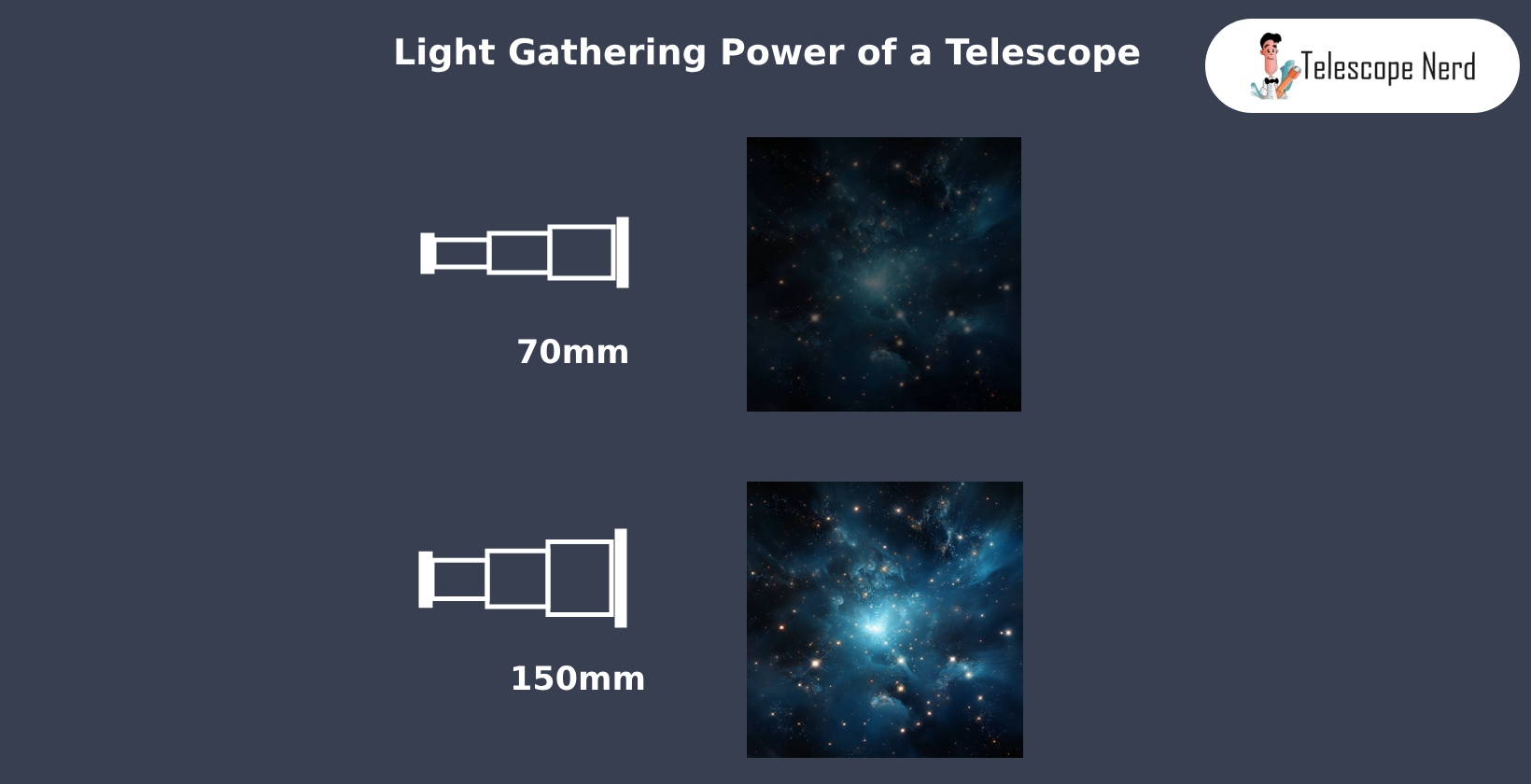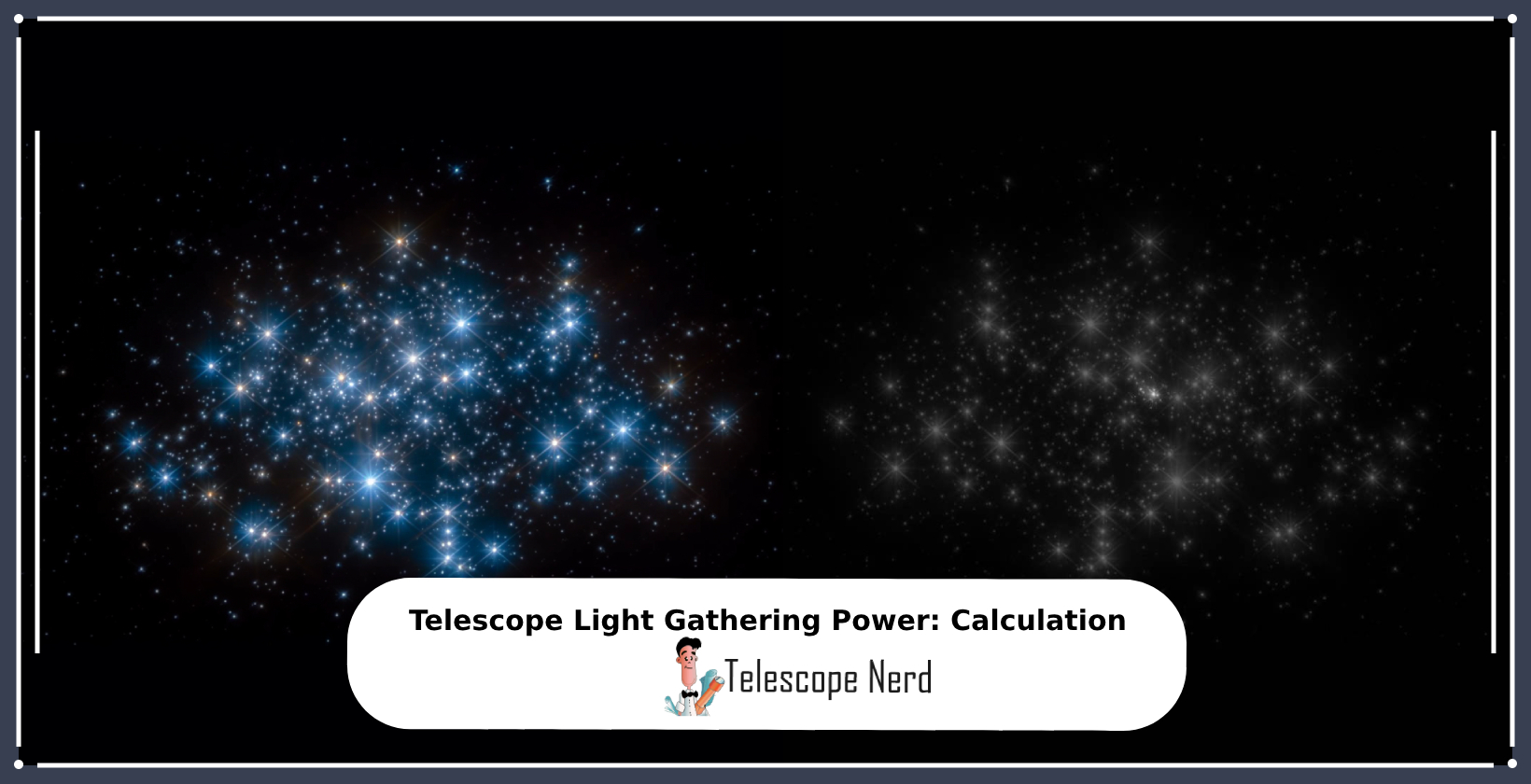Telescope Light Gathering Power: Calculation
The light gathering power (LGP) refers to the telescope’s ability to collect light. Knowing the LGP of a telescope is important because the more light a telescope can gather, the better its ability to observe faint objects in the night sky. The LGP is measured in terms of the area of the telescope’s aperture, usually in square centimeters or square inches.
The larger the aperture, the greater the light gathering power. This is because a larger aperture allows more light to enter the telescope. The importance of LGP lies in its direct impact on the illumination of the image observed through the telescope. A higher light gathering power results in brighter images, making it easier to observe faint objects. An increase in LGP will also improve the resolving power of a telescope, allowing it to provide clearer images of distant celestial bodies. Similarly, the magnification of a telescope, which is the degree to which the image of an object is enlarged, is also influenced by the LGP.
Calculating the light gathering power involves a simple equation that relates the LGP to the square of the telescope’s aperture. This relationship underscores the importance of the aperture in the overall performance of the telescope.
How to Calculate the Light-Gathering Power of a Telescope?
To calculate the telescope’s light-gathering power (LGP) divide the aperture diameter by two, squaring it, and multiplying by pi. The following equation demonstrates how observers can find the area of the aperture.
Aperture Area = π * (Diameter of Telescope Aperture / 2)^2
Typically, LGP is expressed as the ratio of the telescope’s LGP compared to the human eye’s. This ratio allows astronomers to understand the relative strength of their telescopes. Comparisons of different-sized apertures and their light-gathering power are calculated by the ratio of their diameters squared, as expressed in the formula below.
(LGP (a)) / (LGP (b)) = (Aperture Area (a) /Aperture Area (b))2
Because LGP is a direct function of aperture ratio squared, a double in aperture size will result in a 4x increase in LGP. For example, a 10cm objective will collect four times as much light as a 5cm objective. This equation is expressed as ([10 × 10] ÷ [5 × 5] = 4).
This example demonstrates how the light-gathering power of a telescope is enhanced by increasing the diameter of the aperture. This formula is an important consideration when choosing a telescope, as a larger aperture will collect more light and result in brighter images of celestial objects.
Knowing the LGP and how to calculate it is crucial for astronomers and astrophotographers. It allows them to choose the right telescope for their observational goals, depending on the brightness of the objects they wish to observe. Understanding the relationship between the LGP, resolving power, and magnification, also enables them to make the most of their observational activities.
How Does Light Gathering Power of a Telescope Differ from Resolving Power?
Light-gathering power is a telescope’s ability to collect light and enhance brightness, while resolving power is its ability to distinguish between closely spaced objects. The strength of a telescope’s resolving power is based on two main parameters: the wavelength of the observed light and the diameter of the telescope’s aperture.
Resolving power impacts the distinction between closely placed celestial bodies. A telescope with high resolving power is capable of distinguishing these tightly packed astronomical objects, presenting them as separate entities. This concept is of significant importance, especially when studying phenomena such as binary stars or the rings of Saturn.
While light gathering power and resolving power are both important considerations, they affect image quality in different ways. Light-gathering power determines the amount of brightness in an image, revealing faint details. Resolving power determines the telescope’s ability to distinguish these details from each other.
Even though both high LGP and high resolving power are desirable, they don’t always come hand in hand. A telescope might have a high LGP but not necessarily high resolving power, and vice versa. The two abilities, while interconnected, are affected by different parameters and have distinct roles in observational astronomy.
Is Light Gathering Power the Same as Telescope Magnification?
No, light gathering power is not the same as magnification in a telescope. While light-gathering power (LGP) and magnification are both fundamental characteristics of a telescope’s performance, they are not the same. Magnification of telescopes is defined as the capacity of a telescope to magnify the image of a celestial object. The scale of this magnification is dictated primarily by two factors: the focal length of the telescope itself and the focal length of the eyepiece that is utilized.
An object viewed under high magnification will appear larger and its details will be more easily discernible to the observer. Therefore, the degree of magnification and LGP will both influence the quality of the viewing experience when using a telescope.
However, LGP of a telescope isn’t directly correlated with the magnification level. The LGP is a measure of the telescope’s ability to accumulate light. It is primarily determined by the size of the telescope’s aperture – the larger the aperture, the more light is gathered, and consequently, the brighter the image will be. Therefore, a telescope with high LGP accumulates a substantial amount of light, which in turn results in a brighter, more luminous image. Nonetheless, while the LGP enhances the brightness of the magnified image, it does not directly determine the degree to which the image is enlarged, or magnified. The magnification of telescope is solely dependent on the focal lengths of the telescope and the eyepiece, irrespective of the LGP.
Magnification and LGP are integral aspects of a telescope’s performance in observational astronomy, each having a unique influence. While magnification directly influences the size at which an object appears, LGP affects the brightness of the viewed image. Knowing these distinct yet interrelated concepts will substantially enhance the experience of observing celestial objects using a telescope.

